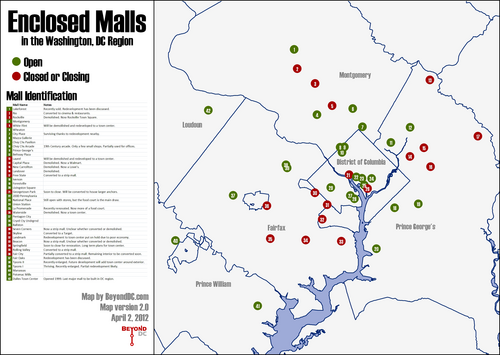Map of Washington’s closed and enclosed malls, version 2
The map of enclosed malls that I posted last week provoked a strong discussion in the comments. Readers made a number of useful suggestions, which I incorporated into this second draft.
The comments generally fell into 2 categories: questions about the definitions, and malls that should be added to the map.
Definitions
For the purposes of this map, an “enclosed mall” is defined as a shopping center in which there is a row of small retail shops that are primarily accessed by pedestrians via an interior walkway. The two key components are small shops and an interior walkway.
Buildings with interior spaces that consist primarily of large format retailers (such as the Pentagon Centre or DCUSA) are not malls for this purpose. Neither are spaces that are primarily food courts. Basically, to qualify as a mall for this map, a shopping center should have a space that looks generally like this.
Additions and subtractions
This second draft includes the following malls that were left out of the first: La Promenade (DC), Waterside (DC), Free State (Bowie), Livingston (Ft Washington), Chevy Chase Pavilion (DC), National Place (DC), Beacon Mall (Mount Vernon), 2000 Pennsylvania Ave (DC), New Carrollton Mall (New Carrollton), Centre at Forestville (Forestville), Rolling Valley Mall (Burke).
The only mall I subtracted from the original map was Virginia Square, which had a department store but apparently never an enclosed row of smaller shops.
I also removed references to “thriving” and “surviving” from the table in the legend, since that was subjective and unclear.
Notable omissions
Shopping centers that could be considered malls but that don’t meet the definition I used for this map include DCUSA, Old Post Office Pavilion, Gallery Place, Pentagon Centre, and the terminals at National and Dulles airports. The airports might technically meet the definition, but they’re obviously a different animal.
 Cross-posted at BeyondDC.
Cross-posted at BeyondDC.

